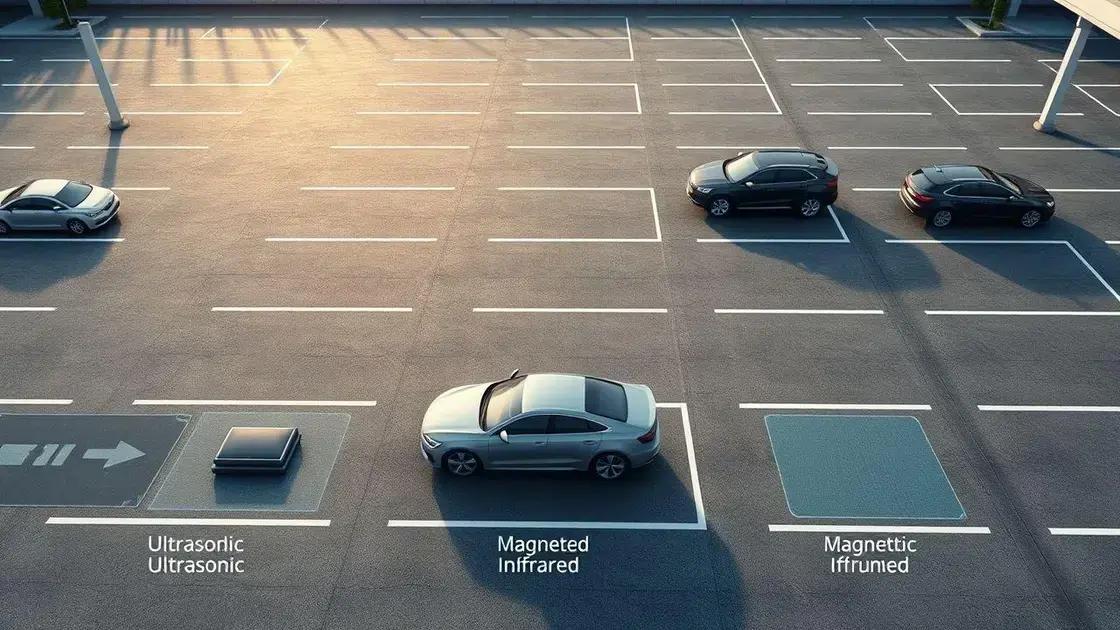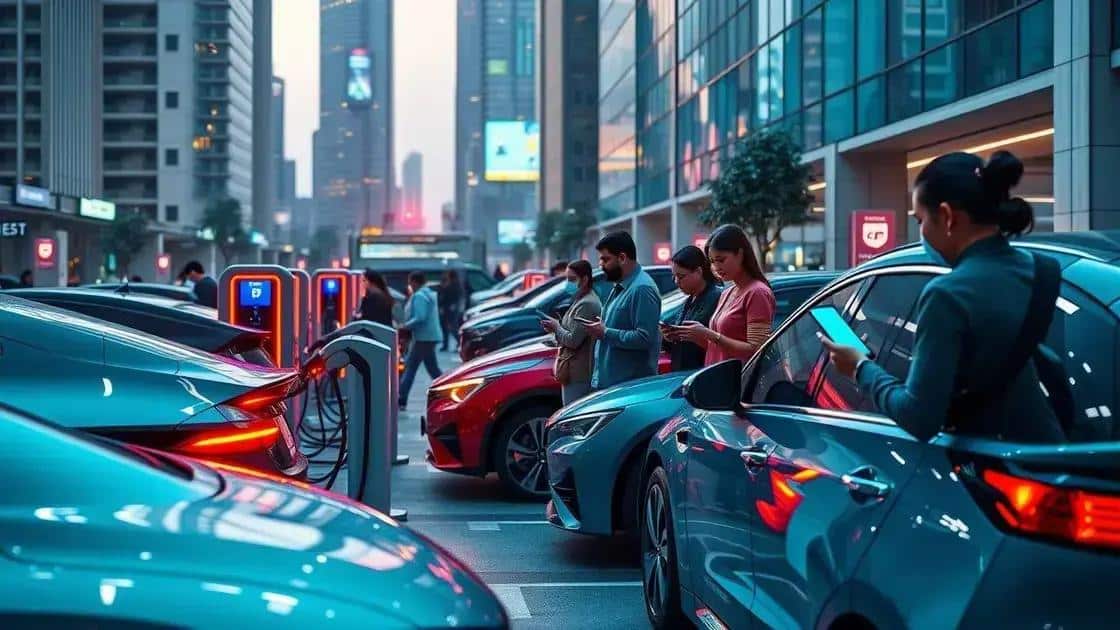IoT-based parking space optimization: save time and money

IoT-based parking space optimization utilizes smart sensors and data connectivity to enhance parking efficiency, benefiting both drivers and operators by simplifying the parking process and improving space utilization.
IoT-based parking space optimization is changing the way we find and use parking spots. Imagine driving into a busy area and knowing exactly where to park without wasting time. In this article, we’ll dive into how this technology works and how it benefits everyone.
understanding IoT and its role in parking management
Understanding IoT and its role in parking management is essential for modern cities. The Internet of Things connects devices and systems to improve efficiency in various sectors, including parking.
Through the integration of sensors and data, parking management systems become smarter. This technology helps minimize the time drivers spend searching for available parking spots.
How IoT Works in Parking
The integration of IoT in parking involves various devices. These devices communicate to provide real-time data about parking availability.
- Smart sensors detect if a parking space is occupied or available.
- Data is transmitted to an app or dashboard for easy access.
- Drivers receive notifications about available spots nearby.
This real-time information not only aids drivers but also assists parking operators in managing spaces efficiently.
Benefits of IoT in Parking Management
Implementing IoT solutions in parking brings numerous advantages. The benefits encourage cities to adopt these technologies for better urban planning.
- Time savings: Less time spent searching for a spot leads to reduced congestion.
- Cost efficiency: Increased revenue from optimized space usage.
- Environmental impact: Decreased emissions due to less driving time.
As cities embrace technology, IoT is becoming more critical in ensuring smart urban management and enhancing the overall driving experience.
how sensors enhance parking space utilization

Sensors play a vital role in enhancing parking space utilization. By providing real-time data, they make it easier for drivers to find available spots. This technology not only saves time but also improves overall parking efficiency.
The integration of sensors into parking management systems allows for better monitoring of available spaces. These devices can detect whether a parking spot is occupied, leading to more effective usage. Additionally, their ability to communicate with mobile applications helps users find nearby available parking.
Types of Parking Sensors
There are various types of sensors that contribute to improved parking space management. Each type has unique benefits that help enhance user experience.
- Ultrasonic sensors: These detect the presence of vehicles using sound waves.
- Infrared sensors: These utilize infrared light to detect parked vehicles.
- Magnetic sensors: These can sense changes in the magnetic field caused by vehicles.
By analyzing data from these sensors, parking operators can optimize their space management strategies.
Benefits of Using Sensors
The advantages of using sensors in parking management are significant. Enhanced data collection leads to informed decisions and strategies that benefit both parking operators and drivers.
- Increased efficiency: Sensors optimize space usage, allowing more cars to park.
- Cost savings: Better space management can lead to reduced operational costs.
- User experience: Drivers enjoy a smoother experience finding parking.
By utilizing sensors effectively, parking facilities can transform their operations, contributing to a better urban environment.
benefits for drivers and parking operators
The benefits of IoT-based parking extend to both drivers and parking operators. These advantages improve the overall parking experience while maximizing operational efficiency.
For drivers, finding a parking space can be stressful and time-consuming. However, with smart parking solutions, this process becomes seamless. Real-time updates on available spots reduce frustration and save valuable time.
Advantages for Drivers
Here are several key benefits that drivers experience with enhanced parking solutions:
- Convenience: Drivers can locate and reserve parking spaces through mobile apps.
- Time-saving: Reduced search times mean drivers can focus on their destination.
- Cost efficiency: Dynamic pricing models help drivers find affordable parking options.
These benefits lead to a more pleasant driving and parking experience.
Advantages for Parking Operators
Parking operators also reap significant rewards from implementing IoT technologies. The integration of smart systems leads to better management and increased revenue.
- Improved space utilization: Operators can monitor parking patterns and optimize space usage.
- Enhanced data collection: Access to real-time data helps with decision-making and strategy planning.
- Increased revenue: Efficient management leads to higher occupancy rates and profits.
With IoT integration, parking management becomes more strategic, benefiting both parties involved. As technology continues to evolve, these advantages will likely expand further.
future trends in smart parking solutions

The future of smart parking solutions is exciting and full of potential. As technology advances, we can expect significant innovations that will transform the parking experience for everyone.
One trend is the increasing use of artificial intelligence to predict parking availability. AI will analyze data patterns and traffic flow to allow drivers to secure spots before they even arrive at the location.
Emerging Technologies
Several emerging technologies are set to change how we think about parking.
- Blockchain: This technology could enhance payment systems by providing secure and transparent transactions.
- Mobile apps: Enhanced applications will offer more features, including online reservations and seamless payments.
- Electric vehicle (EV) charging stations: Integrated solutions with parking available for EVs will become more common.
These advancements will not only improve user convenience but also promote a greener urban environment.
Data Integration and Smart City Initiatives
City planners will increasingly focus on integrating parking data with broader smart city initiatives. This means parking management systems may work alongside public transport and traffic management systems for better overall efficiency.
The shift towards smart solutions will streamline transportation networks, reduce congestion, and empower users with greater control over their parking experiences.
As cities continue to evolve, adopting these trends will be vital for creating sustainable and responsive urban spaces.
IoT-based parking solutions revolutionize how we find and utilize parking spaces. By leveraging technology, both drivers and parking operators enjoy numerous benefits, enhancing efficiency and convenience. The future promises even more advancements, including AI integration and smart city connections, paving the way for a smarter driving experience. As cities evolve, embracing these solutions will be crucial for creating sustainable urban environments.
FAQ – Frequently Asked Questions about IoT-based Parking Solutions
What are IoT-based parking solutions?
IoT-based parking solutions use sensors and data connectivity to monitor parking spaces in real-time, helping drivers find available spots easily.
How do these solutions benefit drivers?
Drivers benefit from increased convenience, reduced search times, and cost-effective parking options through real-time data and mobile applications.
What advantages do parking operators gain from IoT?
Parking operators enjoy better space utilization, enhanced data collection for decision-making, and higher revenue due to increased occupancy rates.
What future trends can we expect in smart parking?
Future trends include the integration of AI for predictive analytics, mobile app enhancements, and the growth of electric vehicle charging stations in parking facilities.





